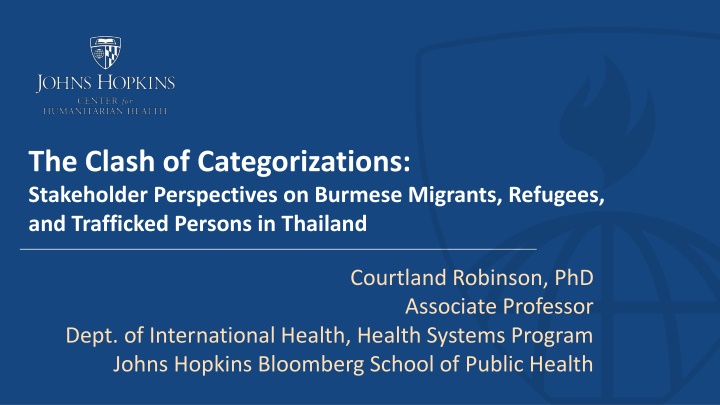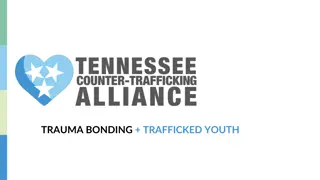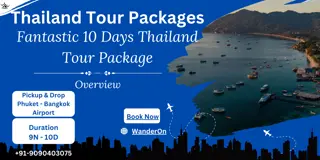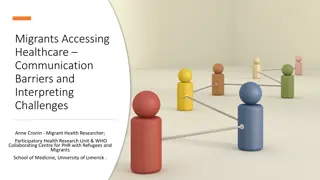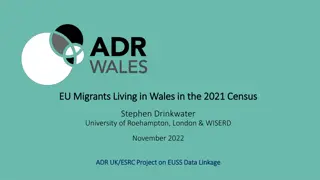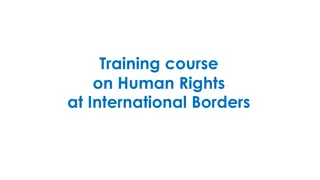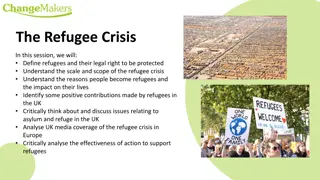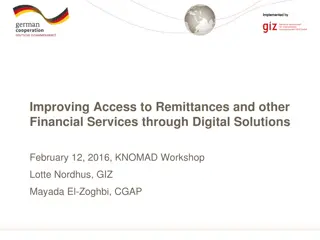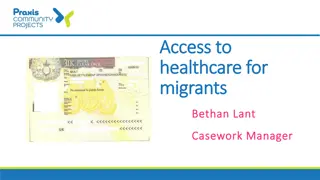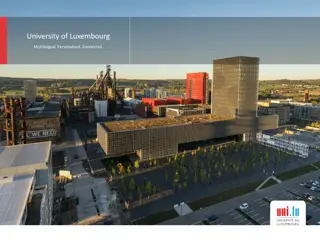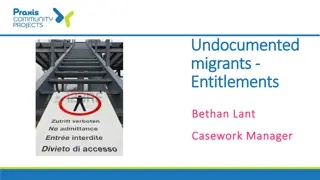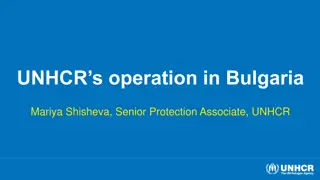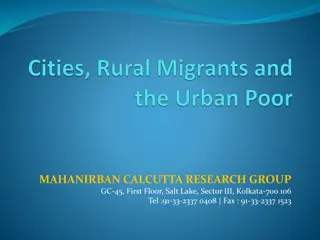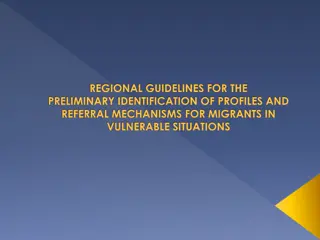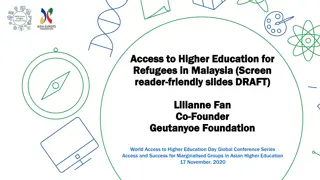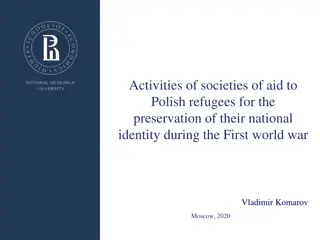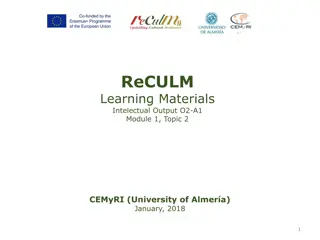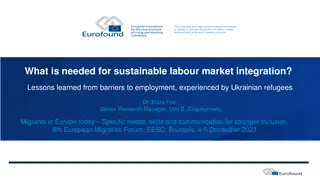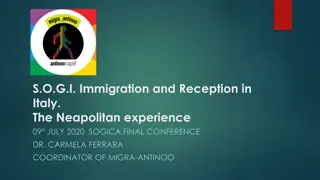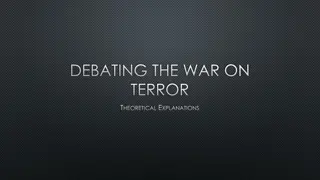The Clash of Categorizations: Burmese Migrants, Refugees, and Trafficked Persons in Thailand
Stakeholder perspectives on the classification and treatment of Burmese individuals in Thailand reveal conflicting views between the Thai state and humanitarian perspectives. The study highlights challenges faced by Burmese migrants and the lack of legal protection due to Thailand's non-signatory status to refugee conventions. Different stakeholders hold varying opinions on how to address issues of migration, trafficking, and labor exploitation.
Download Presentation

Please find below an Image/Link to download the presentation.
The content on the website is provided AS IS for your information and personal use only. It may not be sold, licensed, or shared on other websites without obtaining consent from the author.If you encounter any issues during the download, it is possible that the publisher has removed the file from their server.
You are allowed to download the files provided on this website for personal or commercial use, subject to the condition that they are used lawfully. All files are the property of their respective owners.
The content on the website is provided AS IS for your information and personal use only. It may not be sold, licensed, or shared on other websites without obtaining consent from the author.
E N D
Presentation Transcript
The Clash of Categorizations: Stakeholder Perspectives on Burmese Migrants, Refugees, and Trafficked Persons in Thailand Courtland Robinson, PhD Associate Professor Dept. of International Health, Health Systems Program Johns Hopkins Bloomberg School of Public Health
Outline of Talk (paper co-authored with Casey Branchini and Charlie Thame) The Clash of Categorizations Background Study Methods Findings and Discussion Conclusion Source: LPN, Samut Sakhon, Thailand 2
The Argument A 2015 stakeholder analysis involving interviews with 148* key informants, including officials from the Royal Thai and U.S. Governments, non-governmental and international organizations, and academic institutions revealed that disagreements were most stark when discussions centered on the Burmese in Thailand, particularly their claims as well as the associated rights and protections associated with their recognition as refugees, asylees, and/or as trafficked and exploited workers. The interviews evidenced divergent views between, on the one hand, a Thai state perspective that, whatever their motives for movement, Burmese are entering in breach of immigration laws and deserve only temporary stay at best, and, on the other hand, a broader one might say, humanitarian or rights-based perspective that seeks to apply international norms and categories (refugee, asylum seeker, migrant worker, victim of trafficking) to these same populations. * List available on request 3
The Argument (2) The official Thai view can be best encapsulated in the comments of two Thai Government officials, one of whom said, in describing his agency s roles, the one that links most directly to human trafficking is preventing people from entering the country illegally (RTG, Male(09), 13 Oct.). Or another official, in describing work in his province (bordering Myanmar and significantly impacted by cross-border migration, we don t have human trafficking cases, but we have the undocumented migrant workers that enter illegally many don t have working permits so we are trying to send them back to their country (RTG, Male(06), 13 Oct. 2015). These views are counterposed by a comment from an NGO respondent who called for broader protection, not just chiap, brap, song ok [grab, penalize, and deport] (NGO, Female, 21 Oct. 2015). 4
Background Since the 1970s, Burmese refugees have been crossing into Thailand, escalating in 1988 following the government s crackdown on student protests. Further displacement and migration due to natural disasters, sporadic ethnic conflict (e.g., recent sectarian violence against the Muslim Rohingya in Rakhine State), and ongoing labor migration. Thailand is not signatory to the 1951 Convention on the Status of Refugees, has no legislation that grants refugee status or protection for asylum seekers. The Immigration Act of 1979 prohibits entry to those without travel documentation and those who are dangerous to society or to the peace and security of the Kingdom. The Ministry of Interior s 1954 Regulation Concerning Displaced Persons from Neighboring Countries defines a displaced person as one who escapes from dangers due to an uprising, fighting or war, and enters in breach of the Immigration Act . Even the Burmese living in refugee camps are temporarily displaced, and not refugees. 5
Background (2) IOM s Thailand Migration Report 2011 identified four groups of foreign and/or non-Thai minority populations in Thailand: migrants from Cambodia, the Lao People s Democratic Republic (LPDR), and Myanmar (registered migrants, unregistered migrants; nationality verification (NV) migrants; Memorandum of Understanding (MOU) migrants); ethnic minorities (The Ministry of Interior has registered members of 15 ethnic minorities as Non-Thai nationals. Among those granted permission to reside in Thailand are displaced Burmese nationals, Burmese irregular migrants, [and] displaced Burmese with Thai ancestry ) and Stateless/Nationality-less persons ; stateless persons (Research by Feingold in 2006 identified lack of citizenship or lack of legal status as the single greatest risk factor for young hill tribe people in northern Thailand to be trafficked or exploited Without proper identity documents and recognition of permanent residence, ethnic minority people are considered illegal aliens in their own country ); and displaced persons (also referred to as refugees and asylum seekers). 6
Background (3) In 2008, Thailand passed the Anti-Trafficking in Persons Act (ATIP Act), updating previous legislation passed in 1997. The impetus for this came after cases of labor trafficking were uncovered in 2006, including the Ranya Paew seafood processing factory in Samut Sakhon Province. Exploitative conditions and the use of child labor in the shrimp factory were reported to local NGOs by migrant workers who had managed to escape. Of the approximately 800 Burmese migrants working at the factory, about 60 women and children were identified as trafficking victims and sent to a Bangkok center for victims of trafficking. The men were not covered by anti-trafficking laws and most (approximately 200) were deported as illegal aliens. Estimates of the numbers and types of trafficking victims in Thailand are hotly debated, with disagreement focusing on methods as well as on differing interpretations of key terms (forced labour, exploitation, etc.) 7
Study Methods In 2015, the Royal Thai Embassy in Washington, D.C. commissioned the Johns Hopkins Bloomberg School of Public Health to assess Thailand s anti-trafficking activities and to make recommendations for improving empirical measurement of and documentation of anti-trafficking efforts. The methods included a literature review and Key Informant Interviews (KIIs) with 148 stakeholders interviewed between August and December 2015. The human subjects research protocol was approved by the Johns Hopkins Institutional Review Board. Participants in Thailand were interviewed in five sites (Bangkok, Chiang Mai Province, Samut Sakhon Province, Tak Province, and Ranong Province). In addition to Bangkok, sites were chosen to include a range of areas along land and maritime borders, and with intent to include a variety of different at-risk populations and occupational sectors. 8
Study Methods (2) To protect the views of all key informants, they were assured that no interviews would be tape-recorded. Respondents were also assured that any quotes used in the report would only be attributed to, for example, a Thai Government official (RTG), an NGO staff- member (NGO), an academic (ACA), an International Organization official (IO), or a U.S. Government official (USG). Table 1. Total Number of Individual and Group Interviews Conducted, by Organization Type Format ACAs IOs NGOs RTG USG Other Total Individual 3 5 10 7 3 0 28 Group 2 3 45 68 0 2 120 Total 5 8 55 75 3 2 148 9
Results and Discussion We found there to be significant divergence between the perspectives of Thai government officials and those of many other stakeholders such as non-governmental and international organizations, foreign government officials, and academics, regarding the number and type of individuals who may be regarded as victims of human trafficking. The divergence was about interpretation of terms salient to the definition of a victim of trafficking: what is forced labour? what constitutes exploitation? what is debt bondage? and would its application broaden an understanding of forced labour? Also reflects a clash of categorizations between one that regards non-national victims of trafficking, asylum seekers and others without proper documentation as essentially illegal immigrants for whom deportation is the best solution, and another view that takes a victim-centered approach and calls for a broader protection system. 10
Results and Discussion (2) The official Thai view can be best encapsulated in the comments of two Thai Government officials, one of whom said, in describing his agency s roles, the one that links most directly to human trafficking is preventing people from entering the country illegally (RTG, Male(09), 13 Oct.). Or another official, in describing work in his province (bordering Myanmar and significantly impacted by cross-border migration, we don t have human trafficking cases, but we have the undocumented migrant workers that enter illegally many don t have working permits so we are trying to send them back to their country (RTG, Male(06), 13 Oct. 2015). These views are counterposed by a comment from an NGO respondent who called for broader protection, not just chiap, brap, song ok [grab, penalize, and deport] (NGO, Female, 21 Oct. 2015). 11
Results and Discussion (3) The government should apply victim-centered approaches for victims of trafficking; it seems now they have steps 1, 2, 3, 4, 5 to send people back home. But different victims have different needs. If they have family here they have different needs. If they have physical abuse or something that is not trafficking, they have to be supported too. But in fact the government-process approach does not consider the individual needs of people particularly in terms of social reintegration. (NGO, Male, 12 Oct.) Does the government provide adequate protection? . Basic protection [means] adequate shelter, counselling, medical care, rehabilitation. This is beyond a question of open or closed shelters; some are effectively jails. Victims need to be able to leave when they want. They have to have the ability to get out, or stop and say I m done with this . The Thai law is very good. The 2008 Law has the provision of employment [for victims of trafficking]. It s not being implemented. Victims of human trafficking have legal status, but none have the visa. (NGO, Male, 26 Oct.) 12
Results and Discussion (4) If determined to be a victim of trafficking, individuals have some rights. Or the potential for some rights, in the context. They may be granted a temporary stay permit, [they] may be granted a temporary work permit. This takes the Rohingya out of the cycle of trafficking. If they are free to work, to earn the bus fare to Malaysia, they can do that without use of a trafficker. When an individual is determined to be a victim of trafficking then they are granted this [temporary stay and right to work]. (IO, Male, 23 Oct.) The Anti Trafficking in Persons Law has an article about those who cannot return and the provision of assistance in Thailand until they can return. But the anti-trafficking law does not protect asylum seekers. This is the gap that we have here. Refugees and asylum seekers could be migrant workers as well. [T]he Thai government should provide for a refugee status determination process Uighurs, Rohingyas, Syrians, others. Without that, they are vulnerable to human traffickers to exploit their vulnerabilities because there is no system to protect them.[T]he lack of a system contributes to the problem of human trafficking in the country of origin and when they are in Thailand. (NGO, Male, 12 Oct). 13
Conclusions Thailand s Immigration Act B.E. 2522 (1979) was enacted in the same year that refugee and asylum-seeker arrivals from Cambodia, Laos, and Vietnam reached their zenith, and flight from Myanmar also was rising along Thailand s western border. That law codified a policy to recognize the arrivals not as refugees but as temporarily displaced and effectively illegal at least in terms of their migration status. Residence was restricted to a camp, and the only durable solutions were resettlement in a third country, or return. Also crafted in the context of a growing, cross-border influx this movement comprising primarily migrant workers but also representing a mix flow of refugees and asylum seekers as well Thailand s Anti-Trafficking Act of 2008 aligns substantially with international instruments. But interpretation of specific terms and implementation still suffers from a preoccupying focus on border control and stemming illegal migration. Persons identified as trafficked persons stay in a shelter until they are moved on to a third country (some of the Rohingya) or deported. 14
Conclusions (2) In addition to improvements in labour migration policies to protect migrant workers, several respondents called for the Immigration Act to be amended to permit asylum- seekers to apply for temporary or permanent residence and for trafficking victims to have meaningful alternatives to detention and deportation. [The] Immigration Law is outdated, it is a dinosaur framework, it s from 1978. It s been outdated and not really responding to trends in migration that are happening right now (NGO, Female, 21 Oct). It takes a broader view to see trafficking not just as a matter of criminal justice but to see it as reflecting patterns of labor conditions that are entrenched in society (NGO, Female, 07 Aug.). This broader view must take into account migration policies, labour policies, and the building of stronger local, regional, and international networks to support safe migration and safe borders, decent and dignified work with fair wages and safety for migrant workers, and stronger protections not only against exploitation and abuse of rights but protection against unsafe return. 15
